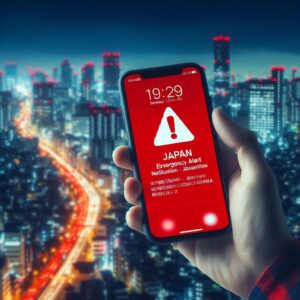Jアラートとは?
Jアラートとは、正式名称を「全国瞬時警報システム」といい、日本政府が運用している緊急情報伝達システムです。自然災害や武力攻撃など、国民の生命や安全に関わる緊急事態が発生した際に、全国の自治体や一般市民に向けて瞬時に警報を伝達するための仕組みです。このシステムは2007年から本格運用が開始され、特に北朝鮮によるミサイル発射の際には、国民の注意を促すための重要な手段として注目を集めてきました。Jアラートの名前が流行語として認知された背景には、緊迫する国際情勢と、それに対する人々の関心の高まりがあります。
どのように発信されるのか
Jアラートは、総務省消防庁が情報を発信元として運用しており、内閣官房などの関係機関からの指示を受けて警報が発出されます。衛星回線を用いて市町村の防災行政無線や緊急速報メール、携帯電話のエリアメール、テレビやラジオなどに一斉に送信され、警告音とともに市民へ情報が伝達されます。通知は数秒から十数秒以内という速さで届くため、危機的状況への迅速な対応が可能とされています。近年ではスマートフォンの普及に伴い、携帯端末への通知が主な情報源となっており、音声や画面表示によってミサイル発射情報などが広く拡散されます。
なぜ「流行語」になったのか
「Jアラート」が流行語として世間に定着したのは、北朝鮮による弾道ミサイルの発射が度重なった2017年頃からです。特に日本上空を通過するようなミサイル発射の際、早朝や深夜に鳴り響く警報音と「ミサイルが発射されました」という画面表示は、日常生活の中で強いインパクトを与えました。その恐怖感や緊張感、そしてそれを受けた人々の反応がSNSなどを通じて拡散され、やがて「Jアラート」という言葉そのものが象徴的に語られるようになったのです。メディアでもたびたび取り上げられ、報道番組では「Jアラート発出時の行動指針」などが繰り返し説明されることで、国民の間での認知が一気に高まりました。
社会に与えた影響
Jアラートの普及とともに、国民の防災意識や危機管理に対する姿勢も変化しました。ミサイル警報が現実に鳴るという事実は、それまで「どこか遠い国の話」としてとらえられていた武力の脅威が、身近なものとして感じられるきっかけとなりました。また、学校や企業などでの避難訓練にもJアラートを想定したシナリオが取り入れられ、地域社会全体での安全確保の取り組みが強化されました。その一方で、誤報や過度の不安を招くという課題も指摘され、Jアラートの情報精度や伝達方法についての議論も活発化しています。
今後の課題と展望
Jアラートは今後も国民の生命と安全を守るための重要なインフラとして、その精度や信頼性の向上が求められます。情報伝達の迅速性と同時に、誤解を招かない明確なメッセージ構成や、聴覚障害者や外国人居住者などへの配慮も必要とされており、システムの改善は継続的な課題です。また、国際情勢の変化に伴い、新たなリスクへの対応力も求められていくでしょう。Jアラートという言葉が流行語として人々の記憶に残った背景には、私たちの生活と国家安全保障が直結する時代に生きているという現実があるのです。
J-Alert, officially called the “National Instant Alert System,” is an emergency information transmission system operated by the Japanese government. It is a system used to instantly transmit warnings to local governments and the general public throughout Japan in the event of a natural disaster, armed attack, or other emergency situation that may affect the lives or safety of the public. This system has been in full-scale operation since 2007, and has attracted attention as an important means of alerting the public, especially in the event of a missile launch by North Korea; the name J-Alert has become a buzzword due to the tense international situation and the growing public concern about it.
How is it transmitted?
J-Alert is operated by the Fire and Disaster Management Agency of the Ministry of Internal Affairs and Communications as the source of information, and alerts are issued in response to instructions from the Cabinet Secretariat and other relevant agencies. Using satellite links, the information is simultaneously transmitted to municipal disaster prevention administrative radio systems, emergency alert e-mails, cell phone area e-mails, TV and radio stations, etc., and the information is conveyed to the public with an audible warning. Notifications arrive within a few seconds to a dozen seconds, allowing for a quick response to a crisis situation. In recent years, with the spread of smartphones, notifications to mobile terminals have become the main source of information, and missile launch information is widely disseminated through audio and on-screen displays.Why did it become a buzzword?
J-Alert” became a buzzword around 2017, when ballistic missiles were repeatedly launched by North Korea. Especially when a missile is launched that passes over Japan, the early morning or late at night, the sound of the alert and the screen display saying “A missile has been launched” had a strong impact in our daily lives. The sense of fear and tension, as well as the reactions of the people who received these alerts, spread through social networking services, and the term “J-Alert” itself came to be used symbolically. The media often covered the event, and news programs repeatedly explained the “Guidelines for Action in the Event of a J-Alert” and other information, which quickly gained public recognition.Impact on Society
Along with the spread of J-Alerts, the public’s awareness of disaster prevention and attitude toward crisis management also changed. The fact that missile alerts were actually sounded triggered a sense of familiarity with the threat of military force, which until then had been regarded as “a story from some distant country. Evacuation drills at schools and businesses also included scenarios based on J-alerts, and efforts to ensure the safety of the entire community were strengthened. At the same time, however, the issue of false alarms and excessive anxiety has been pointed out, and discussions on the accuracy of J-Alert information and communication methods have become more active.Future Issues and Prospects
J-Alerts will continue to be an important infrastructure for protecting the lives and safety of the public, and their accuracy and reliability must be improved. Along with speedy information transmission, clear message structure that does not lead to misunderstanding and consideration for the hearing impaired and foreign residents are also required, making system improvement an ongoing challenge. In addition, as the international situation changes, the ability to respond to new risks will also be required, and the fact that the term “J-Alert” has become a buzzword in people’s memories is due to the reality that we live in an era in which our lives are directly connected to national security.
AIが描いた「Jアラート」







コメント